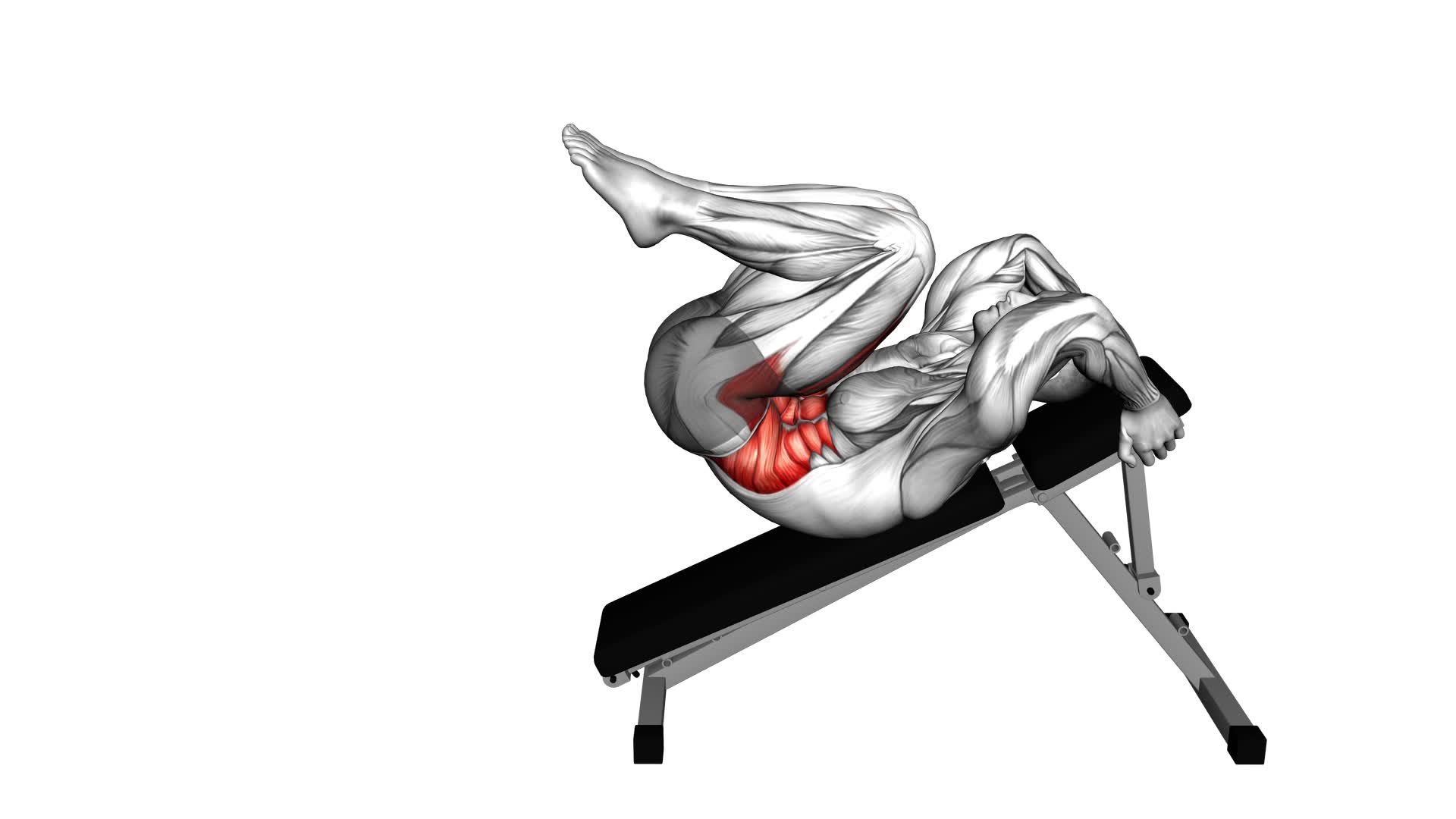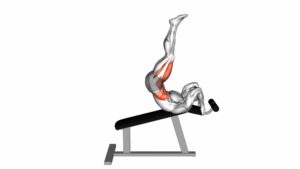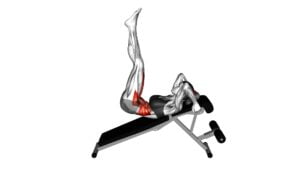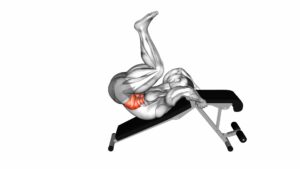Decline Leg Hip Raise – Video Exercise Guide & Tips

Are you looking for an effective exercise to target your lower body? Look no further than the decline leg hip raise.
Watch This Exercise Video
This simple yet powerful move engages your glutes, hamstrings, and core. In this article, we provide a video exercise guide and valuable tips to help you master the proper form and technique.
Discover variations, progressions, and common mistakes to avoid. Get ready to elevate your leg hip raise game and maximize your workout results.
Key Takeaways
- The decline leg hip raise is beneficial for increasing core strength and stability, targeting lower abdominal muscles, improving balance and posture, and enhancing athletic performance.
- Proper form and technique for the exercise include lying on a decline bench, lifting the legs straight up towards the ceiling, engaging the core and squeezing the glutes, maintaining proper alignment, and avoiding arching the back or using momentum.
- Common mistakes to avoid include not maintaining proper form and core engagement, relying on momentum instead of using the hip muscles, struggling with the decline position, and modifying the exercise for beginners by using a stability ball for added support.
- Variations and progressions for the decline leg hip raise include weighted variations, single-leg variations, using resistance bands, performing the exercise on a stability ball, and utilizing different equipment options.
Benefits of the Decline Leg Hip Raise
You will experience increased core strength and stability from performing the Decline Leg Hip Raise. This exercise is highly effective in targeting the lower abdominal muscles, providing numerous benefits for your overall fitness. By engaging your core muscles, you won't only improve your balance and posture, but also enhance your athletic performance in various activities.
The Decline Leg Hip Raise specifically targets the lower abdominal muscles, including the rectus abdominis and the transverse abdominis. These muscles play a vital role in stabilizing the spine and pelvis, and by strengthening them, you can reduce the risk of lower back pain and injuries. Additionally, improved core strength can enhance your ability to perform other exercises and movements, such as squats, deadlifts, and running, with better form and efficiency.
Furthermore, the Decline Leg Hip Raise is an excellent exercise for developing a strong and defined midsection. By consistently incorporating this exercise into your workout routine, you can sculpt and tone your abs, helping you achieve that coveted six-pack look.
Proper Form and Technique for the Decline Leg Hip Raise
To perform the Decline Leg Hip Raise with proper form and technique, begin by lying on your back on a decline bench. Make sure that your head is supported and your feet are secured under the foot pads. Place your hands by your sides or lightly hold onto the bench for stability.
To execute the exercise, start by lifting your legs up towards the ceiling, keeping them straight and together. As you raise your legs, engage your core and squeeze your glutes. Continue lifting until your hips are off the bench and your legs are perpendicular to the floor.
Maintain proper alignment throughout the movement. Avoid arching your back excessively or allowing your lower back to lift off the bench. This can put unnecessary strain on your spine. Instead, focus on keeping your core tight and your lower back pressed into the bench.
Common errors to watch out for include using momentum to swing your legs up, which reduces the effectiveness of the exercise. Additionally, avoid lifting your legs too high, as this can strain your lower back and lead to injury.
Variations and Progressions for the Decline Leg Hip Raise
Continuing from the previous subtopic on proper form and technique, let's explore variations and progressions for the Decline Leg Hip Raise. To challenge yourself further and take your workout to the next level, try these advanced modifications and utilize different equipment options:
- Weighted Decline Leg Hip Raise: Hold a dumbbell or a weight plate on your hips while performing the exercise. This added resistance will increase the intensity and engage your muscles even more.
- Single-Leg Decline Leg Hip Raise: Lift one leg off the bench and perform the exercise using only the other leg. This variation not only targets your glutes and hamstrings but also improves balance and stability.
- Decline Leg Hip Raise with Resistance Bands: Attach a resistance band around your thighs or ankles and perform the exercise. The band will add resistance throughout the movement, making it more challenging for your muscles.
- Decline Leg Hip Raise on Stability Ball: Place your feet on a stability ball instead of the bench. This variation requires more stability and core strength, as you need to balance yourself on the unstable surface.
Common Mistakes to Avoid During the Decline Leg Hip Raise
To ensure proper execution of the Decline Leg Hip Raise and maximize its effectiveness, it's essential to be aware of common mistakes that should be avoided. By avoiding these mistakes, you can prevent injuries and get the most out of your workout.
One common mistake isn't maintaining proper form throughout the exercise. It's important to keep your core engaged and your back flat against the bench.
Another mistake is using momentum to lift your legs instead of relying on your hip muscles. This can reduce the effectiveness of the exercise and increase the risk of injury.
Additionally, beginners often struggle with the decline position and may find it uncomfortable or challenging to perform the exercise correctly. To modify the exercise for beginners, you can start with a smaller decline angle or use a stability ball instead of a bench for added support.
Tips for Getting the Most Out of Your Decline Leg Hip Raise Workout
Get the most out of your Decline Leg Hip Raise workout by incorporating these essential tips:
- Engage your core: To maximize the benefits of the exercise and improve core strength, remember to engage your abdominal muscles throughout the movement. This will help stabilize your body and prevent any unnecessary strain on your lower back.
- Start with modifications: If you're a beginner or have limited strength, it's important to start with modifications. You can begin by performing the exercise with bent knees instead of straight legs. This will reduce the intensity and allow you to focus on proper form before progressing to the full movement.
- Control the movement: As you raise your legs, make sure to maintain control throughout the entire range of motion. Avoid using momentum or swinging your legs, as this can diminish the effectiveness of the exercise. Instead, focus on a slow and controlled movement, feeling the contraction in your core muscles.
- Gradually increase difficulty: Once you have mastered the basic form, you can gradually increase the difficulty of the exercise. This can be done by adding ankle weights or holding a medicine ball between your feet. These variations will challenge your core muscles even more and help you progress towards your fitness goals.
Frequently Asked Questions
How Many Repetitions Should I Do for the Decline Leg Hip Raise?
To determine how many repetitions you should do for the decline leg hip raise, it's important to consider your fitness goals and current fitness level. Start with a number that challenges you but allows you to maintain proper form and technique.
Gradually increase the number of repetitions as you become stronger and more comfortable with the exercise. Remember to listen to your body and adjust accordingly.
Consulting with a fitness professional can also provide personalized guidance.
Can I Do the Decline Leg Hip Raise if I Have Lower Back Pain?
If you're experiencing lower back pain, it's best to avoid the decline leg hip raise exercise. Instead, try alternative exercises that can help alleviate your pain, such as pelvic tilts or glute bridges.
Additionally, incorporating stretching and strengthening exercises specifically designed for lower back pain relief can be beneficial. Remember to always listen to your body and consult with a healthcare professional before starting any new exercise routine.
Is It Necessary to Use a Decline Bench for the Decline Leg Hip Raise?
You don't necessarily need a decline bench for the decline leg hip raise. However, using a decline bench can provide additional benefits and variations to the exercise.
It allows for a greater range of motion, targeting your lower abs and hip flexors more effectively. Additionally, you can modify the exercise by adjusting the angle of the decline bench or adding weights to increase the intensity.
Can I Incorporate Weights or Resistance Bands Into the Decline Leg Hip Raise?
You can definitely incorporate weights or resistance bands into the decline leg hip raise. Adding resistance will increase the challenge and help you build strength in your leg and hip muscles.
You can hold dumbbells on your hips or attach resistance bands to your ankles for added resistance. However, it's important to maintain proper form and start with a weight or resistance band that's appropriate for your fitness level.
How Often Should I Include the Decline Leg Hip Raise in My Workout Routine?
To determine the workout frequency for the decline leg hip raise, consider your overall fitness goals and current routine.
Start by including it 2-3 times per week and gradually increase as your strength improves.
Remember to listen to your body and give yourself enough rest between sessions.
Once you feel comfortable, you can explore variations and progressions to challenge yourself further.
Consistency is key, so find a frequency that works for you and stick to it.
Conclusion
In conclusion, the decline leg hip raise is a highly effective exercise for strengthening and toning the lower body. By engaging the hip muscles and core, it helps improve stability and balance.
Make sure to maintain proper form and technique, and consider incorporating variations and progressions to challenge yourself. Avoid common mistakes and follow these tips to maximize the benefits of your decline leg hip raise workout.
Get ready to see great results in your lower body strength and stability!

Author
Years ago, the spark of my life’s passion ignited in my mind the moment I stepped into the local gym for the first time. The inaugural bead of perspiration, the initial endeavor, the very first surge of endorphins, and a sense of pride that washed over me post-workout marked the beginning of my deep-seated interest in strength sports, fitness, and sports nutrition. This very curiosity blossomed rapidly into a profound fascination, propelling me to earn a Master’s degree in Physical Education from the Academy of Physical Education in Krakow, followed by a Sports Manager diploma from the Jagiellonian University. My journey of growth led me to gain more specialized qualifications, such as being a certified personal trainer with a focus on sports dietetics, a lifeguard, and an instructor for wellness and corrective gymnastics. Theoretical knowledge paired seamlessly with practical experience, reinforcing my belief that the transformation of individuals under my guidance was also a reflection of my personal growth. This belief holds true even today. Each day, I strive to push the boundaries and explore new realms. These realms gently elevate me to greater heights. The unique combination of passion for my field and the continuous quest for growth fuels my drive to break new ground.



